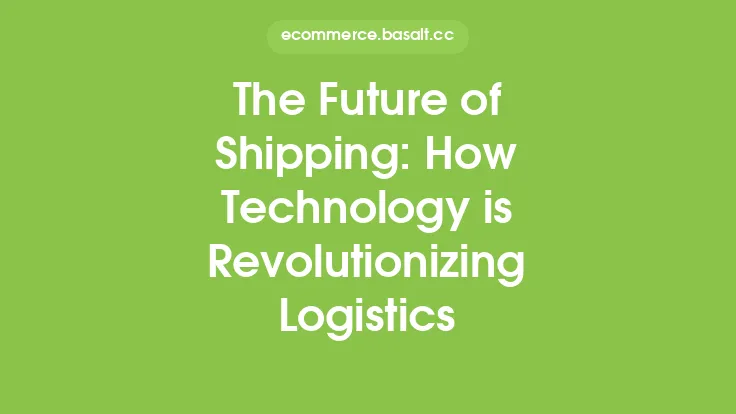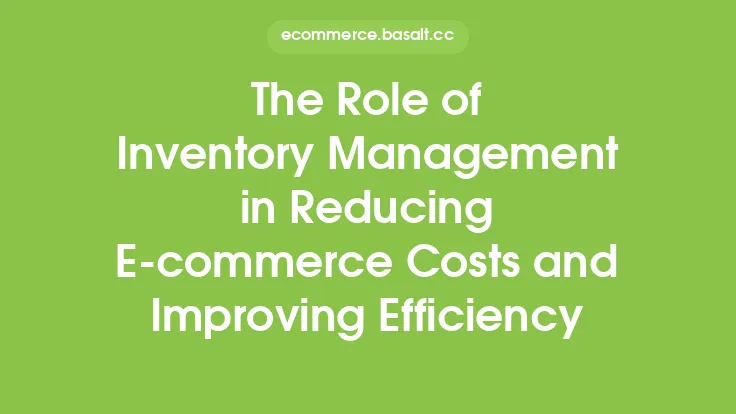The shipping industry has undergone significant transformations in recent years, driven by advances in technology and the increasing demand for efficient and reliable logistics. At the heart of this transformation is data analytics, which has emerged as a key driver of shipping efficiency. By leveraging data analytics, shipping companies can optimize their operations, reduce costs, and improve customer satisfaction. In this article, we will explore the ways in which data analytics is improving shipping efficiency and discuss the benefits and challenges of implementing data analytics in the shipping industry.
Introduction to Data Analytics in Shipping
Data analytics in shipping involves the use of advanced statistical and mathematical techniques to analyze large datasets related to shipping operations. This can include data on shipping routes, vessel performance, cargo handling, and weather patterns, among other factors. By analyzing this data, shipping companies can identify trends, patterns, and correlations that can inform decision-making and drive operational improvements. Data analytics can be applied to various aspects of shipping, including route optimization, cargo management, and supply chain management.
Benefits of Data Analytics in Shipping
The benefits of data analytics in shipping are numerous and well-documented. Some of the key advantages of using data analytics in shipping include:
- Improved route optimization: Data analytics can help shipping companies identify the most efficient routes, reducing fuel consumption and lowering emissions.
- Enhanced cargo management: Data analytics can help shipping companies optimize cargo handling and storage, reducing the risk of damage or loss.
- Better supply chain management: Data analytics can help shipping companies anticipate and respond to disruptions in the supply chain, improving delivery times and reducing costs.
- Increased transparency and visibility: Data analytics can provide real-time visibility into shipping operations, enabling companies to track shipments and respond to issues quickly.
- Cost savings: Data analytics can help shipping companies reduce costs by identifying areas of inefficiency and optimizing operations.
Applications of Data Analytics in Shipping
Data analytics has a wide range of applications in shipping, including:
- Route optimization: Data analytics can be used to identify the most efficient routes, taking into account factors such as weather, traffic, and road conditions.
- Cargo management: Data analytics can be used to optimize cargo handling and storage, reducing the risk of damage or loss.
- Supply chain management: Data analytics can be used to anticipate and respond to disruptions in the supply chain, improving delivery times and reducing costs.
- Vessel performance monitoring: Data analytics can be used to monitor vessel performance, identifying areas of inefficiency and optimizing maintenance schedules.
- Weather forecasting: Data analytics can be used to predict weather patterns, enabling shipping companies to plan routes and schedules accordingly.
Challenges and Limitations of Data Analytics in Shipping
While data analytics has the potential to transform the shipping industry, there are several challenges and limitations that must be addressed. Some of the key challenges include:
- Data quality: Data analytics is only as good as the data it is based on. Poor data quality can lead to inaccurate insights and flawed decision-making.
- Data integration: Shipping companies often have multiple systems and datasets, which can make it difficult to integrate and analyze data.
- Talent and skills: Data analytics requires specialized skills and expertise, which can be difficult to find and retain.
- Cost: Implementing data analytics can be costly, particularly for small and medium-sized shipping companies.
- Security: Data analytics involves the use of sensitive data, which must be protected from cyber threats and other security risks.
Best Practices for Implementing Data Analytics in Shipping
To get the most out of data analytics, shipping companies should follow best practices such as:
- Develop a clear strategy: Define what you want to achieve with data analytics and develop a clear strategy for implementation.
- Invest in talent and skills: Hire experienced data analysts and provide training and development opportunities to build skills and expertise.
- Focus on data quality: Ensure that data is accurate, complete, and consistent, and implement data governance policies to maintain data quality.
- Use cloud-based solutions: Cloud-based solutions can provide scalability, flexibility, and cost savings, making it easier to implement and maintain data analytics.
- Monitor and evaluate: Continuously monitor and evaluate the effectiveness of data analytics, making adjustments and improvements as needed.
Future of Data Analytics in Shipping
The future of data analytics in shipping is exciting and rapidly evolving. Some of the key trends and developments that are expected to shape the industry include:
- Increased use of artificial intelligence and machine learning: AI and machine learning can be used to analyze large datasets and identify patterns and correlations that may not be apparent to human analysts.
- Greater emphasis on sustainability: Data analytics can be used to optimize shipping operations and reduce environmental impact, making it an important tool for sustainable shipping.
- Increased focus on cybersecurity: As data analytics becomes more widespread, cybersecurity will become an increasingly important concern, with shipping companies needing to protect sensitive data from cyber threats.
- Greater use of IoT devices: IoT devices can provide real-time data on shipping operations, enabling companies to track shipments and respond to issues quickly.
- More emphasis on collaboration and partnership: Data analytics can be used to facilitate collaboration and partnership between shipping companies, suppliers, and customers, improving efficiency and reducing costs.





